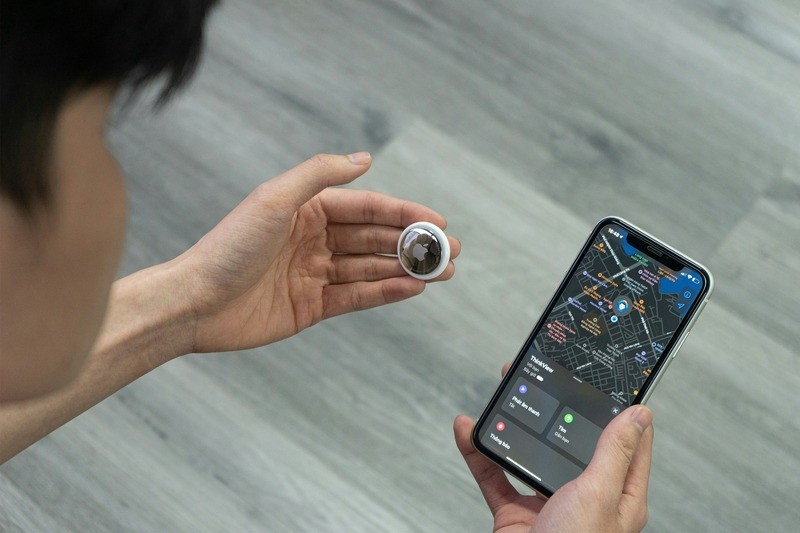Apple AirTags are designed as small, Bluetooth-enabled tracking devices to help you keep tabs on your everyday items like keys and wallets. Utilizing Bluetooth signals, these gadgets send out beacons, updating the location of your tagged belongings on your Apple devices. While incredibly useful for preventing lost items, AirTags have also raised concerns about potential misuse, such as unauthorized vehicle tracking. If you suspect an AirTag might have been placed in your car without your consent, this guide will help you understand how to find it.
How Far Can an AirTag Track?
It’s important to understand that AirTags don’t have built-in GPS for active, long-range tracking. Instead, they rely on the vast network of Apple devices. When an AirTag is within Bluetooth range (approximately 330 feet or 100 meters in ideal conditions) of any Apple device, it leverages that device to update its location on the Find My network. This passive tracking method means AirTags are dependent on the density of Apple devices around them to report their location.
If you’re worried about a potential hidden AirTag in your vehicle, here are practical steps you can take to detect and locate it using both iPhones and Android devices, as well as other methods.
Detecting an AirTag Using Your iPhone
For iPhone users with iOS 14.5 or later, Apple has implemented a built-in feature to automatically alert you if an unknown AirTag is detected moving with you. Here’s how to leverage this feature:
Ensure Location Services and Bluetooth are Enabled
To allow your iPhone to detect unknown AirTags, make sure both Bluetooth and Location Services are activated:
- Navigate to Settings on your iPhone.
- Tap on Privacy & Security (or Privacy on older iOS versions).
- Select Location Services and ensure it is toggled on.
- In Settings, go back and select Bluetooth and ensure it is on.
These settings are crucial for your iPhone to passively scan for nearby AirTags.
Wait for Automatic “Moving with You” Notification
Once the settings are enabled, your iPhone will automatically scan for any unknown AirTags in your vicinity as you travel. This process runs in the background, and you don’t need to actively do anything.
- Drive your car as you normally would.
- The detection process is passive and automatic.
Respond to the AirTag Detection Notification
If an unknown AirTag is detected moving with you for a certain period (typically after a few hours), your iPhone will send a “Moving with you” notification.
- Keep an eye out for notifications from the Find My app.
- This notification indicates an AirTag not associated with your Apple ID has been detected traveling with you.
Investigate the AirTag Details
When you receive the “Moving with you” alert, tap on the notification to get more information:
- Tap the notification to open the Find My app.
- You will see a map displaying the locations where the unknown AirTag has been detected with you.
Play Sound to Pinpoint the AirTag
To physically locate the AirTag in your car, use the “Play Sound” feature:
- In the Find My app, tap Play Sound.
- The AirTag will emit a beeping sound to help you find its precise location within your vehicle.
Learn More About the AirTag
For additional details about the detected AirTag, use the “Learn About This AirTag” option:
- Tap Learn About This AirTag for more information.
- If the AirTag has been marked as lost by its owner, you might see contact information to help return it (though in this scenario, it’s unlikely to be relevant).
Disable the AirTag
Once you find the AirTag, and if you confirm it’s an unknown device and you feel it’s been placed without your consent, you can disable it:
- Follow the instructions provided in the Find My app to remove the battery.
- Typically, this involves pressing and twisting the back cover of the AirTag to open it and remove the CR2032 coin cell battery.
Finding an AirTag with an Android Device
 Finding a hidden AirTag in a car using the Tracker Detect app on a Samsung Android smartphone.
Finding a hidden AirTag in a car using the Tracker Detect app on a Samsung Android smartphone.
If you use an Android phone, you can still scan for AirTags using Apple’s official “Tracker Detect” app, available on the Google Play Store. This app allows you to manually scan for nearby AirTags that might be tracking you.
Download and Use the Tracker Detect App
To get started, download and install the “Tracker Detect” app from the Google Play Store.
- Open the Google Play Store on your Android device.
- Search for “Tracker Detect” by Apple.
- Install the app.
- Open the app and follow the on-screen instructions to scan for nearby AirTags.
Manually Scan for AirTags
Unlike iPhones, Android devices do not have automatic background scanning for unknown AirTags. You need to initiate a manual scan using the Tracker Detect app:
- Open the Tracker Detect app.
- Tap the Scan button.
- The app will scan for nearby AirTags and list any it finds.
- If an AirTag is detected, the app can help you play a sound on the AirTag to locate it.
Other Methods to Find an AirTag in Your Car
Besides using smartphones, here are other methods to detect a hidden AirTag in your vehicle:
1. Listen for Beeping Sounds
AirTags separated from their owners for an extended period (between 8 to 24 hours) will start emitting an audible beep.
- Turn off the car engine and radio.
- Listen carefully for any unfamiliar, periodic beeping sounds inside and outside your car.
- The beeping sound is intentionally not very loud, so a quiet environment helps.
2. Perform a Thorough Physical Search
A manual physical inspection of your car is crucial. AirTags are small and can be hidden in various places.
- Check under all seats, including in seat pockets and underneath the seat cushions.
- Inspect glove compartments, center consoles, and door pockets.
- Look in the trunk, spare tire well, and under floor mats.
- Examine the exterior of the car, including wheel wells, bumpers, and around the license plate.
- AirTags are small, white, and circular, about the size of a coin – look for this distinctive shape.
3. Use Bluetooth Scanning Apps
Third-party Bluetooth scanner apps can detect Bluetooth devices around you, including potentially hidden AirTags.
- Download a Bluetooth scanner app from the App Store (for iPhones) or Google Play Store (for Android).
- Run the scan inside and around your car.
- Look for device names that might indicate an AirTag, such as “AirTag” or strings of numbers and letters that appear unfamiliar.
4. Check for Suspicious Patterns
While not a direct detection method, be aware of unusual patterns that might suggest you are being tracked.
- Notice if someone seems to know your movements or locations without explanation.
- Be alert to any unusual encounters or coincidences that seem related to your car’s whereabouts.
5. Regular Car Checks
Make it a routine to periodically check your car for any foreign devices, especially if you park in public or unsecured areas frequently.
- Incorporate AirTag checks into your regular car maintenance or cleaning routine.
- This proactive approach can help in early detection and removal of any unwanted tracking devices.
Is AirTag Tracking a Cause for Worry?
AirTags are not as sophisticated as dedicated GPS trackers. They do not offer real-time tracking updates and depend on passing Apple devices to refresh location data. This makes them less effective for continuous, real-time surveillance compared to professional GPS tracking devices. If found relatively quickly, an AirTag can be easily disabled by removing its battery.
However, if you find an unknown AirTag and are concerned about unauthorized tracking, it is wise to take it seriously. Document the incident, and if you feel threatened or concerned for your safety, consider informing local authorities.
Disclaimer: This article is for informational purposes only and should not be considered legal or security advice. If you believe you are being unlawfully tracked, consult with law enforcement or security professionals.
